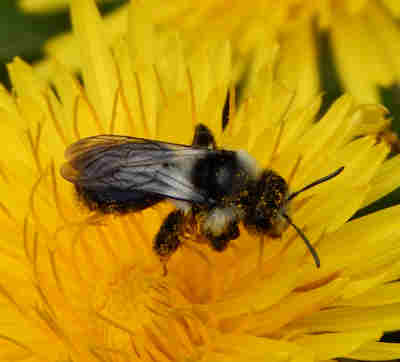Andrena labiata -
Red-girdled mining bee
This is a medium-small Andrena species. Both the male and female have a broad red band on the abdomen - that this is a female is easily given away by the fact she has obvious pollen-collecting hairs on her hind legs.

Males of this species are smaller with an obvious tuft of pale hair on the face.

Below is a photograph of a Andrena labiata - or red-girdled mining bee, foraging on wild garlic.
The photograph was taken in May, when I was at a National Trust property in Wales, UK, called 'Erddig', and I was pleased I had my camera with me (okay, I admit, my pictures won't exactly make National Geographic magazine!).
The patch of wild garlic was in a lightly wooded area of the garden grounds. The sun was shining through the trees.
 Above: Red-girdled mining bee - Andrena labiata (female) foraging on wild garlic.
Above: Red-girdled mining bee - Andrena labiata (female) foraging on wild garlic. Above: Red-girdled mining bee - Andrena labiata (female) resting on wild garlic leaf.
Above: Red-girdled mining bee - Andrena labiata (female) resting on wild garlic leaf.In addition to wild garlic, red-girdled mining bees feed on stitchworts, buttercups, hawthorns, common rock-rose, among others. Andrena labiata can be seen from March through to June.
 Above: Red-girdled mining bee - Andrena labiata (female) in flight.
Above: Red-girdled mining bee - Andrena labiata (female) in flight.
Nesting habits of Andrena labiata - the red-girdled mining bee
Nesting occurs in a range of soils, sometimes in large aggregations, in short or sparse vegetation.
Parasites
If you see the cleptoparasitic bee, Nomada guttulata (a rather small nomad bee) lurking nearby, it could well be an indicator that red-girdled mining bees are in the area too.



